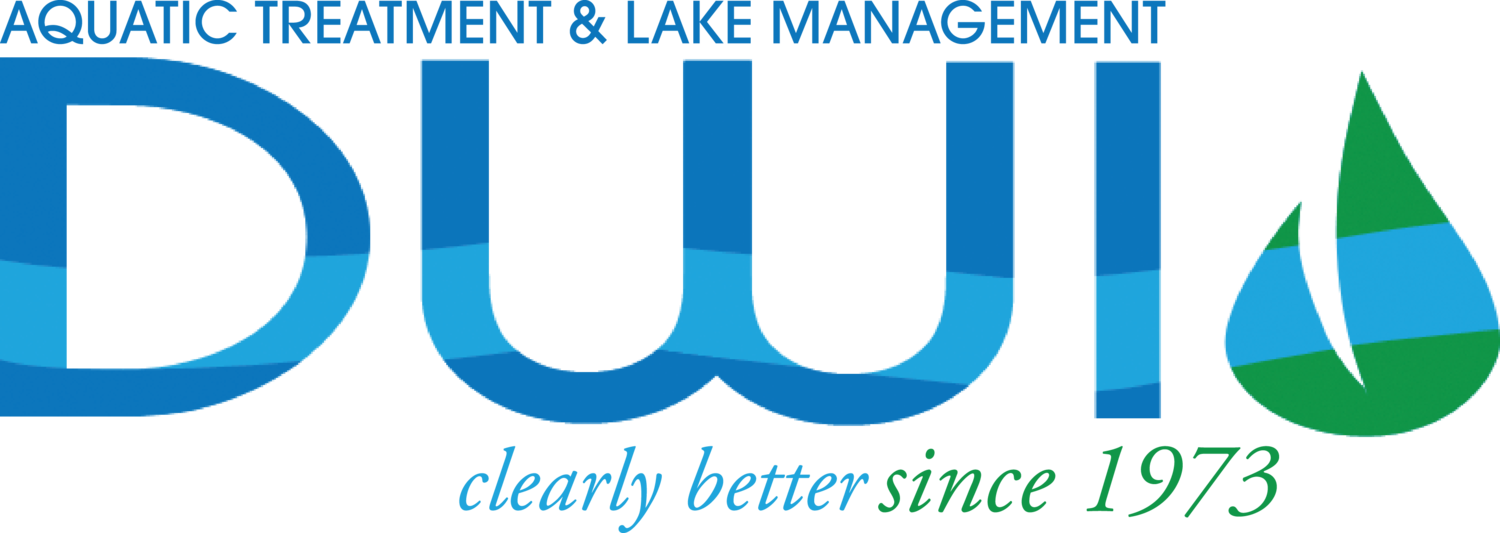By Patrick Simmsgeiger, Founder of DWI
Water features, especially lakes and ponds, are assets that increase the worth and enjoyment of any property. In order to maximize and maintain the highest value for properties associated with lakes, establishing and sustaining a balanced food chain, or more correctly, a food web, is water key to maintaining a healthy, aesthetically pleasing lake that enhances the property year ’round. In this article, we will take a very basic look at a properly established food web in ponds and lakes and how to develop and maintain the ecosystem to preserve the health and beauty of these Aquatic assets.
A typical lake or pond is made up of four zones that have distinguishing characteristics: the shore zone, the surface film zone, open water zone and bottom zone. Although there are no district lines of demarcation between them each of these areas have their own combination of plant and animal life that inhabit them, in the shore zone there are grasses and algae that grow along with critters such as worms, snails, insects, and small fish. Moving out into the water, there is the surface film zone. Insects and surface floating algae that provide part of the food source for the lake’s inhabitants occupy this area. Beneath the surface, is the open water zone. In this zone are the larger fish, phytoplankton, which are the tiny free floating algae that give a pond or small lake its characteristic green color, small animals such as insect larvae, crustaceans, and other invertebrates. Last, there is the bottom water habitat zone. When the plants and animals of the upper layers of the ecosystem die, they fall to this bottom zone where microorganisms like bacteria and fungi feast on them releasing the nutrients and contained energy back into the ecosystem of the pond through the decomposition of the matter.
While the pond has these four habitat zones, the pond food web (or chain, pyramid) is categorized into trophic levels, which is where a particular plant or animal resides in the food chain pecking order. This can’t be looked at as if the different animals that live in a pond are organized into a pyramidal structure. At the bottom of the pond food web pyramid are the primary producers. These are the plants and algae that convert nitrogen, phosphorous, and other minerals into organic material, or simply food, using the energy of the sun through the photosynthetic process. Everything above this level is a consumer. The next trophic level up from the algal producers, the secondary level, are consumers, such as tilapia or bluegill, that eat the algae, as well as insects from the surface zone and other small animals such as worms and crustaceans, and in doing so concentrate the nutrients and energy contained within the organic matter. These low level consumers are then in turn eaten by the fish inhabiting the next trophic level up, which in the pond ecosystem is often bass. Bass are generally at the top level predator of a pond or lake and aggressive hunters and voracious eaters. Of course, moving above and beyond the pond ecosystem, the trophic levels continue as the in the case of the hawk or eagle that eats the bass. However, we are mainly concerned with the food web within the pond ecosystem itself.
The “cycle” of life” of a pond, then, starts with plants, commonly algae, converting free nitrogen and phosphorous into organic material, or simply “food”, through photosynthesis. All life in the pond, and the world at large for that matter, is, in the long run, completely dependent upon the photosynthetic process for food, and therefore life. Oxygen production is a byproduct of this process, replenishing the oxygen in the water for use by other, higher animal forms such as the fish that inhabit the pond. Insects, invertebrates and omnivorous fish such as tilapia then feed on this algae and phytoplankton, concentrating the energy and nutrients contained within these food sources and these, then, become the source of food for the higher level predator fish such as catfish and bass.
In order to imagine the pyramid structure of the food web in a pond, consider this: Bass are the top level predator of the food web in any given pond. A properly managed pond can have as much as 8 pounds of pass per acre. The size of the bass will depend upon their age or the maturity of the pond, but one could easily imagine forty 2 pound bass as a way to approach this 8 pounds of fish. Bass eat ten pounds of food for every pound of body weight, so they need to consumer 1 pound of food for every proud of weight. Therefore, to develop that 8 pound of bass requires 8 pounds of baitfish such as bluegill or tilapia, for the bass to feed on. In turn, these baitfish require as much as a ton of plants or insects as food to consumer in order to develop these population levels. Nevertheless, it’s important to understand that this is not a static condition. There will never be 80 pounds of baitfish in the pond at any given them, as the Food Chain Management Healthy Ponds bass are voracious predators and see to it that the stock of baitfish is always in decline. Therefore, the supporting population of baitfish is continually fluctuating, as the fish spawn and hatch, then grow and then become food for the bass. Bluegill are often stocked in the pond, as they are the only species that can breed fast enough to keep ahead to the bass’ appetite to eat them into extinction. However, occasionally, fresh stock will need to be added to supplement the supporting population of baitfish.
In a new pond, it’s important to stock the water in the proper order with plants and nutrients so that the ecosystem develops a strong and stable base for the introduction of the top level predator. To this end, ponds can be fertilized to encourage algae and plant growth. Then, the primary consumers, such as the tilapia and bluegill can be introduced. Once the stocks of these baitfish become somewhat established, then the bass can be introduced to complete the pond’s food web. Of course, as noted, the bass will be constantly threatening the existence of the baitfish, so it is important to keep the algae in check, chemically if necessary, in order to prevent or mitigate algal blooms which occur in hotter weather, and which can deplete the water of the oxygen that the fish need to survive. If the water in the pond has less than two feet of visibility through the water, there is too much algae and the danger of a destructive bloom in increased. To test the clarity of the water and therefore the concentration of algae, a shiny object such as a pie pan can be nailed to a stick with the length of the stick marked in feet. This gauge is then lowered into the pond allowing one to easily determine the relative clarity of the water.
Although there has been much study of food webs in ponds, lakes, and rivers, keeping a healthy food web in a pond is as much art as science. Testing and trial are key and one must allow for adapting the maintenance of their pond to what is shown to work, and therein lies the challenge and the fun, in maintaining a healthy aquatic ecosystem.



